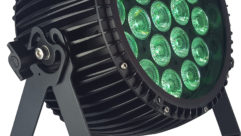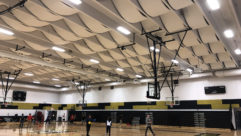Shelter from the Storm
Feb 1, 2003 12:00 PM,
Winn L. Rosch
Once solid-state equipment has been burned in, failures rarely happen without some encouragement. Would-be technicians spill coffee, short outputs, or drive amplifiers into meltdown. But one of the most common causes of premature equipment failure, the surge that sneaks down the power line, is more insidious. Invisible and instantaneous, a single voltage spike from an ailing elevator or a lightning bolt miles away can zap audio or video gear in an instant.
Spikes and surges can strike at any time, destroy every semiconductor in a rack, and leave no telltale sign of their work outside of your suspicions. A single spike can damage tens of thousands of dollars of equipment, pull service technicians to distant sites at any hour, and make clients wonder about the quality of your installation and maintenance.
Although you cannot predict the damage from surges and spikes, you can prevent it. An entire industry offers you the means — power-protection devices. This add-on gear can take any of many forms, from the $5 outlet strip you buy at the store to room-filling uninterruptible power supplies that dent the budgets of the largest corporations.
Unsurprisingly, this menagerie of add-ons varies as widely in effectiveness as cost. The right device is not only insurance against surge-related equipment failures but also an important (and justifiable) addition to any new or existing equipment installation.
PROBLEMS ON THE POWER LINE
Spikes and surges are pollution on the power line, little unwanted extras that get dumped (literally) on wires by natural and human-made phenomena. Both are classed as overvoltage, a higher potential on the power line than your equipment was designed to handle. In the power-protection industry, the distinction between the two is a matter of size and duration. A spike is a brief, nanoseconds-to-microseconds-long pulse of high voltage, typically several thousand volts. The most likely cause is lightning striking power transmission lines or transients when utility companies switch sources. Surges are longer, microseconds to milliseconds, but lower potential pulses, typically caused by the cycling of inductive equipment — for example, motors in refrigerators and elevators going on or off.
Fig. 1 shows an illustration of an oscilloscope trace of an innocuous surge — in this case, a low-intensity pulse of about twice nominal line voltage (about 350V) and relatively long duration, about 1 ms, superimposed on normal, single-phase alternating current. This surge likely would not damage electronic equipment because most power supplies easily smooth it out. Damaging surges would appear as a vertical line that’s far off the scale, about one-thousandth the length and 10 to 20 times the amplitude of the example shown.
Damage from spikes and surges can take several forms. Overvoltages exceed the design ratings of components. Typically, the high voltage directly punches through semiconductor junctions to cause instantaneous failure, or the current in the surge quickly heats and melts junctions. The first semiconductor circuit hit by the overvoltage usually suffers, so the power supply is the first to go. However, because power supplies may fail faster than a fuse or circuit breaker can react, the damage can cascade throughout all the circuitry of audio and video gear, taking out components in every stage. Alternately, some spikes can slip through regulators and end up on the power buses, directly damaging semiconductors anywhere in a piece of gear, anything from a single output transistor to every solid-state device in an amplifier.
In addition to duration and voltage, surges also differ in their mode. Modern electrical single-phase wiring of the type used by professional audio and video equipment, as well as most consumer equipment (including lightbulbs), involves three conductors: a hot, a neutral, and a ground. Hot is the wire that carries the power, neutral provides a return path, and ground provides protection. The ground lead is ostensibly connected directly to the physical earth.
In a properly wired home or office, neutral and ground are the same thing at only one point. The two are bound together at the service entrance where utility power enters a facility, a home, or an office. Usually, this is at the wiring panel — your fuse box or circuit-breaker panel. The National Electrical Code (NEC) requires this one-point grounding. At any other point beyond the wiring panel, the neutral may (and often does) carry a voltage different from ground.
A surge can occur between any pairing of conductors: hot and neutral, hot and ground, or neutral and ground. The first pairing is termed normal mode. It reflects a voltage difference between the power conductors used by electronic gear. When a surge arises from a voltage difference between either current-carrying wire — hot or neutral — and the ground wire, it is called common mode. Surges caused by utility switching and natural phenomena — for the most part, lightning — occur in the normal mode. They have to because of the binding together of neutral and ground at the service entrance. (They are also bound together at the utility line transformer typically hanging from a telephone pole near your home or office.)
At that point, neutral and ground must have the same potential. Any external common mode surge becomes normal mode. Common mode surges can, however, originate within a building because long runs of wire stretch between most outlets and the service entrance, and the resistance of the wire allows the potential on the neutral wire to drift from that of ground. Although opinions differ, recent European studies suggest that common mode surges are the most dangerous to your equipment. (European wiring practice is more likely to result in common mode surges because the bonding of neutral and ground is made only at the transformer, not at the service entrance.)
In that electronic circuitry should be isolated from electrical ground (as opposed to signal ground), common mode surges should not affect audio and video gear, at least when wiring is up to code. A large enough common mode surge can, however, arc over or induce currents that cause damage.
SURGE PROTECTION DEVICES
Manufacturers in the power-protection industry offer several devices aimed at stopping surges.
A surge suppressor is a device that stops surges from getting to your equipment. The term is used loosely and can describe anything from cheap, disreputable devices that afford dubious protection to well-made (and often expensive) protection gear backed by manufacturers with solid reputations and strong warranties. A surge suppressor protects your equipment from surges, so it is sometimes called a surge protector.
Similarly, a power conditioner could be almost anything — manufacturers use the term for a wide range of devices. However, more reputable manufacturers use the term to distinguish devices that do more than the simple suppression of surges. Most true power conditioners include noise filtering, such as keeping light dimmers out of microphone preamplifiers. Some may even provide voltage regulation.
Uninterruptible power systems (UPSs) provide power from a battery source during utility failures. Most also offer surge suppression and power conditioning. Although popular in mission-critical applications (like computer networks) they probably have less value in audio and video installations.
No matter what its manufacturer calls it, a device that is tested and listed by Underwriters Laboratories (UL) to stop surges is called a transient voltage surge suppressor (TVSS). For your safety and that of your clients, look for surge suppressors that are listed as TVSSs by the UL. The listing assures that the listed product has been tested and is not likely to pose harm to you (for example, through electrocution) and is not likely to cause a fire.
A UL listing does not, however, assure that a surge protector will actually protect your equipment. “UL does not evaluate the effect of the TVSS on connected loads or harmonic distortion of the supply voltage, or the adequacy of the suppression level to protect connected equipment from damage due to transient voltage surges,” the UL has stated.
SERIES AND SHUNT PROTECTION
Some manufacturers divide protection devices into series and shunt designs, a distinction that highlights philosophical differences underlying their designs. The two designs actually reflect two different technologies for discriminating spikes and surges from normal utility power. In general, shunt-mode devices act directly by limiting the voltage of a surge. Series-mode devices are reactive components that filter unwanted frequencies from the supply. Because surges take the form of short, sharp pulses, they act as high-frequency signals. Because of its frequency-sensitive nature, the series-mode surge protector also acts as a form of power conditioner.
Shunt-mode surge suppressors use several devices and technologies to block high voltages. The most common of these are metal-oxide varistors (MOVs), gas tubes, and avalanche diodes. Each has its strengths, and some protection devices use combinations of those technologies.
MOVs are the most popular surge protection components, and they are in everything from bargain-basement outlet strips to expensive UPSs. An MOV, as illustrated in Fig. 2, typically consists of a layer of zinc-oxide particles held between two electrodes. The granular zinc oxide offers a high resistance to the flow of electricity until the voltage reaches a break-over point. The electrical current then forms a low-resistance path between the zinc-oxide particles that short out the electrical flow. RCA, now part of GE, invented the MOV.
MOVs earned their popularity because of their low cost. On the downside, they degrade as they protect. Each surge etches a path through the MOV, reducing its resistance to electrical flow until the MOV finally shorts out. Often there is no external indication that a MOV has failed. Sometimes, however, it fails catastrophically — it can explode or catch fire. Better MOV-based surge suppressors provide fuses or circuit breakers to mitigate the effects of MOV failure. They should also provide an indicator that warns when the MOV has failed.
Gas tubes are self-descriptive: tubes filled with special gases with low dielectric potential designed to arc-over (that is, start conducting electricity) at predictable low voltages — a spark gap in a bottle. Gas tubes can handle a great deal of power, thousands of kilowatts, and react quickly, typically in about a nanosecond. They are faster than MOVs and are less likely to be damaged by large surges. But gas tubes don’t turn on or start conducting until a surge reaches two to four times the voltage rating of the tube. Moreover, they stop conducting slowly, sometimes as long as a few cycles after the end of a surge, creating a brief power interrupt to your equipment.
Avalanche diodes are semiconductors similar to zener diodes that offer a high resistance to electrical flow until the voltage applied to them reaches a break-over potential, at which point they switch on. The fastest of all surge-suppression devices, they are often used to catch spikes that sneak past MOVs and even gas tubes. But they handle only modest powers — 600W to 1,500W — and may succumb to a single potent surge.
Series-design surge suppressors use reactive circuits that take advantage of the high-frequency nature of most spikes and surges. Reactance is the quality of an electrical component or a circuit that causes it to resist the flow of alternating current. Reactance is like resistance in a DC circuit, but it is frequency dependent, allowing engineers to design reactive circuits that allow signals or power at one frequency to flow through unimpeded while stopping those at other frequencies. The typical reactive surge suppressor uses a large inductor that passes low frequencies (such as the 60 Hz of utility power in the United States) but resists the level of the high frequencies in the sharp voltage rise of a surge. In effect, the reactance spreads out the surge into a long but low-voltage variation.
In addition, the reactance of the surge suppressor can be tuned to convert the surge into a semblance of a normal AC waveform, conditioning the power. The reactive surge suppressor also absorbs any other high frequencies, such as noise, that appear on the power line. The noise-filtering circuitry of shunt-design surge suppressors also uses reactive components, though at a smaller scale not meant to handle the full power of a surge.
The chief drawback of the series-design reactive surge suppressor is the cost of the large inductor required, which makes it inherently more expensive, larger, and heavier. They don’t readily fit into outlet strips, but they can be competitive with larger power-protection devices such as true power conditioners. In addition, most commercial reactive series-mode surge suppressors eliminate only normal-mode surges. But series-design power-protection devices do not degrade or wear out as do MOV-based shunt-style suppressors. In other words, they are heavy-duty, long-lasting components.
A new type of power conditioner that also provides surge suppression uses a fully active design to gain the effects of a large inductor without the expense. These active power conditioners follow the series-design scheme but work like double-conversion UPSs without the batteries. That is, they convert utility power into direct current — eliminating spikes, surges, noise, and voltage irregularities along the way — and then reconvert the DC back into AC for your equipment. By using high-frequency power conversion circuitry (much like that in a switching power supply), these devices avoid the need for large, expensive inductors, as shown in the inside view of a solid-state power conditioner in Fig. 3. This style of power conditioner affords the best possible surge protection (short of an actual double-conversions UPS) by totally isolating your equipment from the vagaries of the power line.
CLAMPING DOWN
During normal operation, shunt-connected surge suppressors do essentially nothing. Their design is such that they act as electrical insulators until the voltage across their leads reaches a potential called the clamping voltage, at which point they start conducting electricity to create the surge-killing short circuit. In effect, they almost instantly switch from being an electrical insulator to a good conductor. They give the electrical surge a low-resistance direct path that bypasses your equipment.
The clamping voltage of the components inside a commercial surge suppressor produces the most important rating of the product, the let-through voltage. This measure indicates the maximum voltage the entire surge suppressor allows to reach your equipment after surge suppression, noise reduction, and power-line conditioning. One of the most misleading notions among prospective purchasers of surge suppressors is that the clamping voltage of the components inside (thus, the rated let-through voltage) should be as low as possible. For example, some people believe that a surge suppressor with a clamping voltage of 130V would be the best protection for a 120V connection. Such notions are simply wrong. Because of the nature of alternating current, any such surge protector would last for no more than a few seconds.
The nominal voltage of line current in the United States, 120V, is what engineers call the average or RMS voltage. But every cycle of alternating current reaches a peak value about 1.414 times higher than this voltage. That is, the voltage at your wall outlet varies between 0V and 170V 60 times per second.
Obviously, a 130V surge suppressor will see a 170V surge 60 times per second. To guard against these 170V surges, the 130V surge protector would short-circuit the power line 60 times per second and would soon wear out, overheat, or even explode. The absolute minimum clamping voltage for the components in a surge suppressor operating in a normal 120V circuit is 180V. In actual applications, however, even that voltage level is too conservative and will likely lead to premature device failure.
Underwriters Laboratories rates surge suppressors as to let-through voltage. Under UL specifications, the minimum let-through voltage that a product can claim — thus, the best let-through voltage rating of a UL product — is 330V. Lower claims are not possible; let-through voltage ratings higher than 330V indicate a product that affords less protection. In theory, voltage is irrelevant to a series-design surge suppressor because it filters power based on frequency. Increase voltage slowly enough, and an inductor will let it pass. Commercial units include additional circuitry to shunt high voltages, though their reactive circuits provide the primary protection.
INSTALLATION
If you’re on a budget, theoretically, you could buy a handful of MOVs and solder them to the power inputs of each piece of gear you install (after the fuses, to reduce the risk of catastrophic failure).
This minimalist strategy works but has drawbacks. Because of the finite life of MOVs, you would need to periodically replace them. Tinkering inside your equipment will void warranties. The safer strategy is to use commercial surge suppressors, described in the industry as point-of-use devices. They are meant to protect only a single device or a few devices — the equipment that you plug in to them. Series-design surge suppressors are rated for maximum load, which dictates the number of pieces of gear you can connect. Shunt-design suppressors are rated only to their surge-handling ability, though practical wiring considerations (standard outlets under the NEC) limit most to 15 amperes capacity.
Most outlet strips with surge suppression, particularly the low-cost models, offer little more than one to three MOVs as protection. Although name brands are likely to be more expensive, most add supplemental suppression components. Figs. 4 and 5 compare the circuitry of a low-cost outlet strip with MOV-based surge suppression and a commercial surge suppressor that’s marketed as such.
A series-mode surge protector must be located between the source of the surge and your equipment. Plug the surge suppressor or power conditioner in to an outlet and then plug your gear in to the surge suppressor. A shunt-mode surge protector could, in theory, be located anywhere in an electrical circuit as long as it can provide a substantially lower resistance path to ground. As a practical matter, however, even shunt-mode surge suppressors are interposed between utility power — the surge source — and your gear.
The alternative to the point-of-use device is whole-premises surge protection that is installed in your fuse box or breaker panel. Whole-premises surge suppressors have the advantage that they protect everything connected through a breaker panel from utility power problems. Simple whole-premises protection surge suppressors might seem an ideal solution, but they require access to the power panel, which clients and building owners may be reluctant to grant, particularly if you are not a licensed electrician. You’re also unlikely to install whole-premises protection if your equipment is mobile and you move from site to site as jobs dictate.
A welcome trend in the powerprotection industry is rackmount packaging for power-protection equipment. You can bolt a single- or two-space device into the rack for both permanent and portable installation. A single point-of-use device can provide power distribution as well as protect an entire rack from surges. Nothing prevents you from using whole-premises and point-of-use surge suppression together. In fact, many experts recommend using both to gain the utmost in protection.
Think of surge protection as insurance. Adding a surge suppressor to an installation won’t change its sound or video quality, but it may improve the quality of your life. You and your clients will have one thing less to worry about — the unpredictable, often invisible damage caused by power line problems.
Winn L. Rosch writes extensively about technology. His book, the Winn L. Rosch Hardware Bible, is in its sixth edition.










